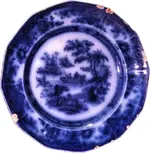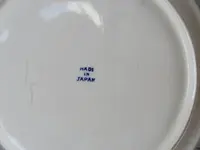I don’t think that’s a Moriyama plate, nor is it ‘flow blue’. Moriyama items (the pottery was established in 1911 in MoriMachi, Japan) are almost invariably marked with their name, or a logo including the letters ‘M’ or ‘MM’. The ‘flow blue’ assignation for china is widely misused for anything having a deep cobalt blue colour, but it properly refers to a specific type of blue glaze developed in the 1820s in Staffordshire, England (then spreading elsewhere). The name derives from the fact that the blue colouration of the glaze flowed during firing, creating a blurred edge and a kind of halo effect around the design, which I don’t see on your plate. The decoration is pretty crisp from what I can see.
I would say it’s what is loosely known as “Chinoiserie”… mass-produced in (often unidentified) Chinese and Japanese factories, mainly from the late 1800s onwards, as exportware to the West. When hand painted, that’s almost always marked as such on the back (because it commanded a price premium), and I think your plate will be transferware, with the pattern applied via a paper stencil. Date-wise, I would think sometime around the 1920s-1930s.
The design is “willow pattern”. Despite the oriental appearance, it was conceived by one of Thomas Minton’s artists in England some time around 1790 and has been widely copied by china manufacturers ever since, including mass production in Japan. It’s still in production today. Minton’s artist took his inspiration from styles he had seen on porcelain imported from China in the late 18th Century and, as a marketing ploy, Minton also invented a fable to add a bit of mystique to the design. It goes something like this, although it has no links whatsoever to China (or Japan) and is complete modern fiction:
A wealthy Mandarin has a beautiful daughter called Koong-se. The daughter falls in love with her father’s accounting assistant called Chang. The Mandarin is angry because Chang is a commoner. Chang gets the boot and the Mandarin builds a high fence around his palace to stop the lovers from meeting. His preferred partner for his daughter is a Duke, who arrives by boat with a box of jewels as a wedding gift, and the nuptials are planned for the first day the blossom falls from the willow tree. On the eve of the wedding, Chang sneaks into the palace in disguise and does a runner with Koong-se and the jewels. The alarm is raised and the Mandarin pursues them over a bridge with a whip in his hand. The lovers steal the Duke’s boat and escape to a remote island, where they live happily for years. The Duke eventually learns where they are and sends soldiers to kill them. The gods transform the lovers’ spirits into a pair of doves.
If you look at the plate in detail, you will see all the elements of that story. The doves (at the top of the plate) were a later embellishment to the story and the early designs don’t have them.





